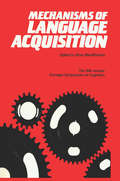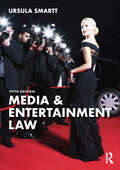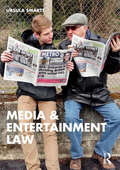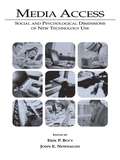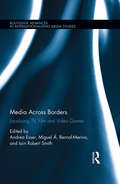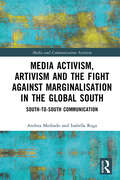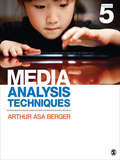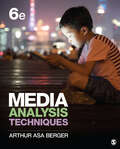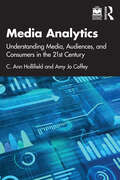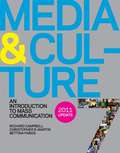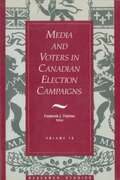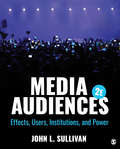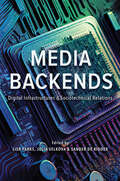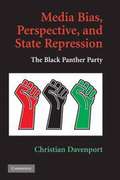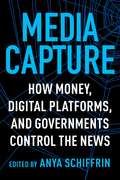- Table View
- List View
Mechanisms of Language Acquisition: The 20th Annual Carnegie Mellon Symposium on Cognition (Carnegie Mellon Symposia on Cognition Series)
by Brian MacWhinneyFirst published in 1987. Three decades of intensive study of language development have led to an enormous accumulation of descriptive data. But there is still no over-arching theory of language development that can make orderly sense of this huge stockpile of observations. Grand structuralist theories such as those of Chomsky, Jakobson, and Piaget have kept researchers asking the right questions, but they seldom allow us to make detailed experimental predictions or to formulate detailed accounts. The papers collected in this volume attempt to address this gap between data and theory by formulating a series of mechanistic accounts of the acquisition of language.
Media & Culture: An Introduction to Mass Communication
by Richard Campbell Ron Becker Christopher Martin Bettina FabosGet to the heart of fake news and brush up on your media literacy skills as you explore the media landscape of today, and where it all came from, using the current and relevant research found in Media & Culture.
Media & Entertainment Law
by Ursula SmarttNow in its fifth edition, this textbook combines comprehensive coverage with rigorous analysis of a key area of the law. The author illuminates how the courts strive to strike a balance between the freedoms and responsibilities of the press on the one hand and an individual’s right to privacy on the other. Maintaining its coverage of the law across the UK (including Scotland and Northern Ireland) and the EU, the new edition has been brought up to date with expert insights into significant developments and judgments, including: the impact of changes in intellectual property law, data protection, GDPR and copyright law post Brexit – including the cases of Schrems II and Ed Sheeran; analysis of new case law and developments in privacy and freedom of the media – including Duchess of Sussex (Meghan Markle) v The Mail on Sunday and ZXC v Bloomberg; the introduction of new Scottish defamation laws and the importance of defamatory meaning; the response to disinformation, fake news and social media – including tweeting jurors and contempt. With a variety of pedagogical features to encourage critical thinking, this unique textbook is essential reading for media and entertainment law courses at undergraduate and postgraduate levels and an insightful resource for students and reflective practitioners of journalism, public relations and media studies.
Media & Entertainment Law
by Ursula SmarttNow in its sixth edition, this leading Media and Entertainment Law textbook continues to combine comprehensive coverage with rigorous analysis of a key area of the law.The sixth edition has been comprehensively updated, reflecting in particular the enormous changes brought about by artificial intelligence and how it is influencing not only intellectual property law (e.g. music copyright), but also common law development in the UK, EU and US. Topics covered include the regulation of online harms, and new legislation in the form of the Online Safety Act 2023 and the Media Act 2024. This edition also looks across European borders to US legislation in areas such as copyright, internet regulation, defamation and contempt. Case law features noteworthy examples such as Vardy v Rooney – the Wagatha Christie Trial (2021), and other topics covered include tweeting jurors and contempt, and Prince Harry, The Duke of Sussex’s legal actions against the tabloid press on phone hacking and invasion of privacy.With a variety of pedagogical features to encourage critical thinking, this unique textbook is essential reading for media and entertainment law courses at undergraduate and postgraduate levels and an insightful resource for students and reflective practitioners of journalism, public relations and media studies.
Media Access Control and Resource Allocation
by Jingjing Zhang Nirwan AnsariThis book focuses on various Passive optical networks (PONs) types, including currently deployed Ethernet PON (EPON) and Gigabit PON (GPON) as well as next generation WDM PON and OFDM PON. Also this book examines the integrated optical and wireless access networks. Concentrating on two issues in these networks: media access control (MAC) and resource allocation. These two problems can greatly affect performances of PONs such as network resource utilization and QoS of end users. Finally this book will discuss various solutions to address the MAC and resource allocation issues in various PON networks.
Media Access: Social and Psychological Dimensions of New Technology Use (Routledge Communication Series)
by Erik P. Bucy John E. NewhagenIn Media Access: Social and Psychological Dimensions of New Technology Use, editors Erik P. Bucy and John E. Newhagen present the latest work, theoretical explorations, and original research findings on media access from a team of internationally renowned media and technology researchers. Chapters develop expanded definitions and conceptual understandings of access to stimulate further research, offer new perspectives on policy discussions, and facilitate media participation among those at risk of being left behind. Broadening our understanding of information technology use, this collection offers: *Novel perspectives--chapters demonstrate new methods of addressing persistent questions regarding motivation, cultural context, socioeconomic resources, technical knowledge, and psychological skills required for effectual use of information and communication technologies. *Conceptual integration--each chapter addresses a vital aspect of media access and summarizes pertinent findings, weaving together results to provide much-needed integration across communication and technology studies. *Multidisciplinary approaches--chapters represent a variety of conceptual and methodological approaches, deriving social explanations from large-scale survey data, psychological explanations from experimental data, and cultural explanations from depth interviews and ethnographic methods. *Shifting the policy and research agenda--this volume extends and redirects aspects of the digital divide debate while elaborating the "media access" approach to studying new technology use. Taken as a whole, Media Access reveals complications associated with full access to new communication technologies and proposes analytical frameworks that open new avenues of scholarly investigation and policy consideration. It is intended for scholars and graduate students in journalism, mass communication, telecommunications, media studies, information science, public policy, psychology, sociology, informatics, human-computer interaction, and other disciplines concerned with the issue of media access.
Media Across Borders: Localising TV, Film and Video Games (Routledge Advances in Internationalizing Media Studies)
by Iain Robert Smith Andrea Esser Miguel Á. Bernal-MerinoWhat happened when Sesame Street and Big Brother were adapted for African audiences? Or when video games Final Fantasy and Assassins’ Creed were localized for the Spanish market? Or when Sherlock Holmes was transformed into a talking dog for the Japanese animation Sherlock Hound? Bringing together leading international scholars working on localization in television, film and video games, Media Across Borders is a pioneering study of the myriad ways in which media content is adapted for different markets and across cultural borders. Contributors examine significant localization trends and practices such as: audiovisual translation and transcreation, dubbing and subtitling, international franchising, film remakes, TV format adaptation and video game localization. Drawing together insights from across the audiovisual sector, this volume provides a number of innovative models for interrogating the international flow of media. By paying specific attention to the diverse ways in which cultural products are adapted across markets, this collection offers important new perspectives and theoretical frameworks for studying localization processes in the audiovisual sector. For further resources, please see the Media Across Borders group website (www.mediaacrossborders.com), which hosts a ‘localization’bibliography; links to relevant companies, institutions and publications, as well as conference papers and workshop summaries.
Media Activism, Artivism and the Fight Against Marginalisation in the Global South: South-to-South Communication (Media and Communication Activism)
by Andrea Medrado Isabella RegaThis book analyses a South-to-South connection between media activists and artivists – artists who are activists – in the Global South. The authors, Andrea Medrado and Isabella Rega, emphasise the urgent need to engage in South-to-South dialogues in order to create more sustainable connections between Global South communities and as an essential step towards identifying and facing global problems, such as state repression, social inequality and climate crises. Medrado and Rega analyse the characteristics of this connection, identify its unique contributions to the study of media and social change and discuss its long-term sustainability. They do so by focusing on instances when media narratives in countries of different Global South(s) intertwine and transform each other; specifically, the exchanges between Latin America (Brazil) and Africa (Kenya). They explore how media activism and artivism can be used as tools for global movement building and to challenge colonial legacies. They also discuss how to connect people with varied skill sets in different Global South contexts, promoting South-to-South solidarity, in a cross-continental challenge to marginalisation. Crucial reading for students and scholars of media activism, social movements, global media and communication, development studies and international studies, as well as activists and social movement organisations.
Media Analysis Techniques
by Dr Berger Arthur AIn the Fifth Edition of Media Analysis Techniques, author Arthur Asa Berger provides students with a clearly written, user-friendly, and hands-on guide to media criticism. He empowers readers to make their own analyses of the media rather than just accepting the interpretations of others. The book first examines four techniques of media interpretation—semiotic theory, Marxist theory, psychoanalytic theory, and sociological theory—that Berger considers critical for creative people to acknowledge if they are to understand how their creations translate to the real world. Application chapters then link popular culture to these four theories. Written in an accessible style that demystifies complex concepts, the book also includes a comprehensive glossary, study guides, and the author’s own illustrations.
Media Analysis Techniques (Commtext Ser. #No. 10)
by Arthur A, Berger"This book provides a concise, thought-provoking, and cleverly-written introduction to major theories in media analysis, and it gives students new perspectives on the media they use." —Donna Halper, Lesley University In the Sixth Edition of Media Analysis Techniques, author Arthur Asa Berger once again provides students with a clearly written, user-friendly, hands-on guide to media criticism. The book empowers readers to make their own analyses of the media rather than just accept how others interpret the media. Media Analysis Techniques begins by examining four basic techniques of media interpretation—semiotic theory, Marxist theory, psychoanalytic theory, and sociological theory—that Berger considers critical for creative people to acknowledge if they are to understand how their creations translate to the real world. Application chapters then link popular culture to these four theories. Written in an accessible style that demystifies complex concepts, Media Analysis Techniques includes learning exercises, a glossary, study guides, and the author’s own illustrations. New to the Sixth Edition: A new chapter on discourse analysis offers students techniques for analyzing the language in texts. New content on psychological impact of social media shows that there are often negative consequences to using social media. Increased coverage of technology and social media helps readers apply time-tested analysis techniques to the latest media. Updated examples from popular culture bring theory to life. New drawings and photo images illustrate concepts and enhance the visual attractiveness of this book. New material around generational differences describe to students how each generation interacts with media differently, particularly the millennials. New discussions by thinkers who have made major impacts on popular culture, such as Daniel Chandler on semiotic codes Michel Foucault on change in cultures Mark Gottdiener on sign vehicles in semiotic theory Guy Debord on the Society of Spectacle Mark Thompson et al on Marx’s neglect of egalitarian political culture Marcel Danesi on myth and popular culture Ernest Kris on the Oedipus Complex Sigmund Freud on the purposes of jokes Clotaire Rapaille on the new "Global code." Teun van Dyk on discourse analysis and ideology Wolfgang Iser on reception theory
Media Analysis Techniques (Commtext Ser. #No. 10)
by Arthur A, Berger"This book provides a concise, thought-provoking, and cleverly-written introduction to major theories in media analysis, and it gives students new perspectives on the media they use." —Donna Halper, Lesley University In the Sixth Edition of Media Analysis Techniques, author Arthur Asa Berger once again provides students with a clearly written, user-friendly, hands-on guide to media criticism. The book empowers readers to make their own analyses of the media rather than just accept how others interpret the media. Media Analysis Techniques begins by examining four basic techniques of media interpretation—semiotic theory, Marxist theory, psychoanalytic theory, and sociological theory—that Berger considers critical for creative people to acknowledge if they are to understand how their creations translate to the real world. Application chapters then link popular culture to these four theories. Written in an accessible style that demystifies complex concepts, Media Analysis Techniques includes learning exercises, a glossary, study guides, and the author’s own illustrations. New to the Sixth Edition: A new chapter on discourse analysis offers students techniques for analyzing the language in texts. New content on psychological impact of social media shows that there are often negative consequences to using social media. Increased coverage of technology and social media helps readers apply time-tested analysis techniques to the latest media. Updated examples from popular culture bring theory to life. New drawings and photo images illustrate concepts and enhance the visual attractiveness of this book. New material around generational differences describe to students how each generation interacts with media differently, particularly the millennials. New discussions by thinkers who have made major impacts on popular culture, such as Daniel Chandler on semiotic codes Michel Foucault on change in cultures Mark Gottdiener on sign vehicles in semiotic theory Guy Debord on the Society of Spectacle Mark Thompson et al on Marx’s neglect of egalitarian political culture Marcel Danesi on myth and popular culture Ernest Kris on the Oedipus Complex Sigmund Freud on the purposes of jokes Clotaire Rapaille on the new "Global code." Teun van Dyk on discourse analysis and ideology Wolfgang Iser on reception theory
Media Analytics: Understanding Media, Audiences, and Consumers in the 21st Century
by Ann Hollifield Amy Jo CoffeyThis textbook takes a case study approach to media and audience analytics. Realizing the best way to understand analytics in the digital age is to practice it, the authors have created a collection of cases using datasets that present real and hypothetical scenarios for students to work through. Media Analytics introduces the key principles of media economics and management. It outlines how to interpret and present results, the principles of data visualization and storytelling, and the basics of research design and sampling. Although shifting technology makes measurement and analytics a dynamic space, this book takes an evergreen, conceptual approach, reminding students to focus on the principles and foundations that will remain constant. Aimed at upper-level students in the fast-growing area of media analytics in a cross-platform world, students using this text will learn how to find the stories in the data and how to present those stories in an engaging way to others. Instructor and Student Resources include an Instructor’s Manual, discussion questions, short exercises, and links to additional resources. They are available online at www.routledge.com/cw/hollifield.
Media And Culture: An Introduction To Mass Communication, Seventh Edition with 2011 Update
by Richard Campbell Bettina Fabos Christopher R. MartinThe #1 introduction to mass communication text, Media and Culture offers a critical approach to media literacy, a cultural perspective, compelling storytelling, and comprehensive coverage of the media industries to help students understand the complex relationship between the mass media and our shared culture. And, because each year brings numerous changes in the media — whether it’s exploring new trends like Twitter, thinking about the future of journalism, or trying a Kindle for the first time — the Seventh Edition 2011 Update helps you bring the latest media trends into the classroom and into context.
Media And Voters In Canadian Election Campaigns
by Frederick J. FletcherThis volume presents five studies on the relationship between the media and voters. Each examines some aspects of the flow of information to voters during election campaigns and all reflect the assumption that the right to vote must include the right of access and sufficient information to make an informed decision. In separate studies, Jean Crête and Robert MacDermid examine existing studies and data on the relationship between attention to media and voter information and behaviours. Both studies discuss methods for improving voter information. Televised leaders debates have become an important feature of democratic elections. Cathy Widdis Barr examines the effects of these debates on Canadian voters in 1984 and 1988, concluding that they were an important source of campaign information for less-informed voters. Robert Bernier and Denis Monière provide the most comprehensive comparative overview available on the importance of televised leaders debates and the policy issues surrounding them in democratic countries. Finally, Lyndsay Green examines the potential of new communication technologies for improving the information available to voters during campaigns, with particular attention to voters with special information needs. Taken together, the five studies provide a useful overview of the effectiveness of various forms of campaign communication in informing voters. Much of the material presented here is not readily available elsewhere.
Media Anthropology
by Eric W. Rothenbuhler Dr Mihai ComanMedia Anthropology represents a convergence of issues and interests on anthropological approaches to the study of media. The purpose of this reader is to promote the identity of the field of study; identify its major concepts, methods, and bibliography; comment on the state of the art; and provide examples of current research. Based on original articles by leading scholars from several countries and academic disciplines, Media Anthropology provides essays introducing the issues, reviewing the field, forging new conceptual syntheses.
Media Audiences: Effects, Users, Institutions, and Power
by John L. SullivanDespite the widespread use of the term "audience" in our popular culture, the meaning of "audience" is complex, and it has undergone significant historical shifts over time. Media Audiences explores the concept of media audiences from four broad perspectives, as "victims" of mass media, as market constructions and commodities, as users of media, and as producers and subcultures of mass media.
Media Audiences: Effects, Users, Institutions, and Power
by John L. SullivanWhether we are watching TV, surfing the Internet, listening to our iPods, or reading a novel, we all engage with media as an audience. . Despite the widespread use of this term in our popular culture, the meaning of "audience" is complex, and it has undergone significant historical shifts as new forms of mediated communication have developed from print, telegraphy, and radio to film, television, and the Internet. Media Audiences: Effects, Users, Institutions, and Power 2nd Edition explores the concept of media audiences from four broad perspectives: as "victims" of mass media, as market constructions and commodities, as users of media, and as producers and subcultures of mass media. The goal of the text is for students to be able to think critically about the role and status of media audiences in contemporary society, reflecting on their relative power in relation to institutional media producers.
Media Audiences: Effects, Users, Institutions, and Power
by John L. SullivanWhether we are watching TV, surfing the Internet, listening to our iPods, or reading a novel, we all engage with media as an audience. . Despite the widespread use of this term in our popular culture, the meaning of "audience" is complex, and it has undergone significant historical shifts as new forms of mediated communication have developed from print, telegraphy, and radio to film, television, and the Internet. Media Audiences: Effects, Users, Institutions, and Power 2nd Edition explores the concept of media audiences from four broad perspectives: as "victims" of mass media, as market constructions and commodities, as users of media, and as producers and subcultures of mass media. The goal of the text is for students to be able to think critically about the role and status of media audiences in contemporary society, reflecting on their relative power in relation to institutional media producers.
Media Backends: Digital Infrastructures and Sociotechnical Relations (Geopolitics of Information)
by Jonathan Cohn Vicki Mayer Ranjit Singh Mark Andrejevic Lisa Parks Zala Volcic Amanda Lagerkvist Anne Kaun Tim Markham Kaarina Nikunen Stine Lomborg Rahul Mukherjee Vibodh Parthasarathi Philippe Bouquillion Jacek Smolicki Fredrik Stiernstedt Christine Ithurbide Faithe Day Sander De Ridder Fatima Gaw Alexis Logsdon Philipp Seuferling Matilda Tudor Julia VelkovaExploring how we make, distribute, and consume today’s media systems Media backends--the electronics, labor, and operations behind our screens--significantly influence our understanding of the sociotechnical relations, economies, and operations of media. Lisa Parks, Julia Velkova, and Sander De Ridder assemble essays that delve into the evolving politics of the media infrastructural landscape. Throughout, the contributors draw on feminist, queer, and intersectional criticism to engage with infrastructural and industrial issues. This focus reflects a concern about the systemic inequalities that emerge when tech companies and designers fail to address workplace discrimination and algorithmic violence and exclusions. Moving from smart phones to smart dust, the essayists examine topics like artificial intelligence, human-machine communication, and links between digital infrastructures and public service media alongside investigations into the algorithmic backends at Netflix and Spotify, Google’s hyperscale data centers, and video-on-demand services in India. A fascinating foray into an expanding landscape of media studies, Media Backends illuminates the behind-the-screen processes influencing our digital lives. Contributors: Mark Andrejevic, Philippe Bouquillion, Jonathan Cohn, Faithe J. Day, Sander De Ridder, Fatima Gaw, Christine Ithurbide, Anne Kaun, Amanda Lagerkvist, Alexis Logsdon, Stine Lomborg, Tim Markham, Vicki Mayer, Rahul Mukherjee, Kaarina Nikunen, Lisa Parks, Vibodh Parthasarathi, Philipp Seuferling, Ranjit Singh, Jacek Smolicki, Fredrik Stiernstedt, Matilda Tudor, Julia Velkova, and Zala Volcic
Media Bias, Perspective, and State Repression: The Black Panther Party
by Christian DavenportThis book examines information reported within the media regarding the interaction between the Black Panther Party and government agents in the Bay Area of California (1967-1973). Christian Davenport argues that the geographic locale and political orientation of the newspaper influences how specific details are reported, including who starts and ends the conflict, who the Black Panthers target (government or non-government actors), and which part of the government responds (the police or court). Specifically, proximate and government-oriented sources provide one assessment of events, whereas proximate and dissident-oriented sources have another; both converge on specific aspects of the conflict. The methodological implications of the study are clear; Davenport's findings prove that in order to understand contentious events, it is crucial to understand who collects or distributes the information in order to comprehend who reportedly does what to whom as well as why.
Media Capital: Architecture and Communications in New York City (The History of Communication)
by Aurora WallaceIn a declaration of the ascendance of the American media industry, nineteenth-century press barons in New York City helped to invent the skyscraper, a quintessentially American icon of progress and aspiration. Early newspaper buildings in the country's media capital were designed to communicate both commercial and civic ideals, provide public space and prescribe discourse, and speak to class and mass in equal measure. This book illustrates how the media have continued to use the city as a space in which to inscribe and assert their power. With a unique focus on corporate headquarters as embodiments of the values of the press and as signposts for understanding media culture, Media Capital demonstrates the mutually supporting relationship between the media and urban space. Aurora Wallace considers how architecture contributed to the power of the press, the nature of the reading public, the commercialization of media, and corporate branding in the media industry. Tracing the rise and concentration of the media industry in New York City from the mid-nineteenth century to the present, Wallace analyzes physical and discursive space, as well as labor, technology, and aesthetics, to understand the entwined development of the mass media and late capitalism.
Media Capture And Corrupt Journalists: How Europeanization Helped Build Façades of Democracy (St Antony's Series)
by Tomislav MaršićThis book explores the form, dynamics, and main reasons for media capture and conspiracy between editors and executive politicians in Central and Eastern Europe (CEE) since 2000. Situated in the literatures on Europeanization, democratization, party studies, and media studies, the book aims to connect these fields by showing that internal party dynamics play an important role in motivating executive politicians to hijack or collaborate with media. Against this backdrop, the book tells the story of Croatian journalism in the context of media-mafia conglomerates, political corruption, and media hijacking, and examines how "traditional" democratic drivers that the literature frequently cites, such as Europeanization and party competition, failed to prevent systematic transgressions by politicians. Methodologically, the book takes a two-pronged approach. First, nearly 50 interviews were conducted with Croatian investigative journalists, from which the narratives about the relationships between government politicians and editors over 15 years were reconstructed. In a second step, a sample of 40,000 media articles was subjected to a computational sentiment analysis, covering the same 15-year period and showing high levels of cooperation between corrupt politicians and corrupt media outlets.
Media Capture in Africa and Latin America: Power and Resistance (Palgrave Studies in Journalism and the Global South)
by Hayes Mawindi Mabweazara Bethia PearsonHow can current debates on ‘media capture’ be understood within the contexts of Africa and Latin America? This edited collection provides a nuanced exploration of media capture—a critical yet contested concept that examines and illuminates how media can become skewed in favour of power—while also highlighting spaces and strategies of resistance. By adopting a South-South perspective, it brings together scholars focused on these issues in both regions, featuring a dialogue between two leading scholars, Herman Wasserman and Silvio Waisbord in the Foreword. The book not only demonstrates how media practices in Africa and Latin America are influenced by the political economy of their media systems, but also contributes significantly to advancing empirical, theoretical, and comparative research on media in non-Western settings.
Media Capture: How Money, Digital Platforms, and Governments Control the News
by Edited by Anya SchiffrinWho controls the media today? There are many media systems across the globe that claim to be free yet whose independence has been eroded. As demagogues rise, independent voices have been squeezed out. Corporate-owned media companies that act in the service of power increasingly exercise soft censorship. Tech giants such as Facebook and Google have dramatically changed how people access information, with consequences that are only beginning to be felt.This book features pathbreaking analysis from journalists and academics of the changing nature and peril of media capture—how formerly independent institutions fall under the sway of governments, plutocrats, and corporations. Contributors including Emily Bell, Felix Salmon, Joshua Marshall, Joel Simon, and Nikki Usher analyze diverse cases of media capture worldwide—from the United Kingdom to Turkey to India and beyond—many drawn from firsthand experience. They examine the role played by new media companies and funders, showing how the confluence of the growth of big tech and falling revenues for legacy media has led to new forms of control. Contributions also shed light on how the rise of right-wing populists has catalyzed the crisis of global media. They also chart a way forward, exploring the growing need for a policy response and sustainable models for public-interest investigative journalism. Providing valuable insight into today’s urgent threats to media independence, Media Capture is essential reading for anyone concerned with defending press freedom in the digital age.
Media Career Guide: Preparing For Jobs In The 21st Century (Twelfth Edition)
by Sherri Hope Culver Nichole HarkenTargeted to today's media-savvy students, the eleventh edition of Media Career Guide includes the latest information on the emerging employment opportunities in mobile media, as well as tips for developing and honing professional networking skills. This essential manual provides an updated, comprehensive directory of media jobs, and walks readers through the entire job-search process, from researching a company to applying for jobs to displaying appropriate behavior in the workplace.
